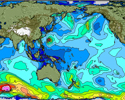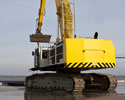Waves 101
Point, Reef or Beach Break?
 One of the most important concepts to understand when considering the different types of waves found at a reef, point, or sandbar is refraction, which bends a wave. Refraction explains what happens when open ocean swells meet the shallow sea floor and the energy becomes directed. SurfScience did some quick research and wants you to know how bathymetry, the geometry of the sea-floor, affects the waves you’re hunting and riding.
One of the most important concepts to understand when considering the different types of waves found at a reef, point, or sandbar is refraction, which bends a wave. Refraction explains what happens when open ocean swells meet the shallow sea floor and the energy becomes directed. SurfScience did some quick research and wants you to know how bathymetry, the geometry of the sea-floor, affects the waves you’re hunting and riding.
In simple terms, refraction is the bending of a wave as it travels over different depths. Anytime you have one part of a wave travelling faster than another section of the wave, the wave bends toward the slower part. This makes sense when you realize that a wave will slow down as it approaches shallow areas of water. As the rest of the wave bends toward the slower moving section, the energy will be focused toward the shallow areas of water. In their book SurfScience, Tony Butt and Paul Russell make the analogy of a car hitting the breaks on only one side. The other side of the car will veer in the direction of the car’s slower half.
REEF
So let’s imagine a wave approaching a shallow stretch of reef surrounded by fairly deep water. As the wave hits the reef it slows down. The sections of the wave to the left and to the right of the reef continue at the same speed and bend toward the shallow section. According to Butt and Russell, this focuses all energy toward the middle and is called concave refraction or focusing. The result is a bigger and more powerful wave. Pipeline, anyone?
POINT
Now picture a headland sticking out with deep water bay to its side. As the swell approaches land, the wave hitting the point will slow down and the section going over the deep water will not lose any speed. The wave will bend away from the deep water, toward the point. Over the deep water the wave will grow weaker, with its energy spread over a wide area instead of focusing on one spot. Butt and Russell identify this as defocusing, or convex refraction. Therefore, at a point we see less powerful waves but they are much longer and will not decrease in size as you go down the line.
BEACH-BREAK
Now let’s think of a beach with various sandbars running along its length. Using the laws of refraction, we can expect the waves to focus on the sandbars (shallow water) and lose energy in the deeper areas (channels). This scenario results in various peaks up and down the beach. Butt and Russell point out an exception, where a beach may be surrounded by two headlands. The headlands would attract the wave’s energy and defocus the energy along the entire length of the beach, resulting in weak closeouts.
As the next swell heads toward your part of the world take a moment to consider the direction it’s headed and where you can take advantage of the wave’s refraction. Knowing where to tap into the wave’s energy will help you maximize the swell and give you some great stories to tell. Pity the uninformed, but not too much.






1 Comment